 Selfies are by no means an exclusively modern phenomenon. As shown in a previous post on medieval selfies, some decorators made self-portraits in manuscripts, showing that the practice predates print – albeit without the use of a camera. They did so to identify themselves as the creator of a miniature or historiated initial, or even to exhibit their accomplishments as businessmen, as the early-sixteenth-century commercial illustrator Nicolaus Bertschy appears to do. Other medieval examples of selfies are those by Matthew Paris, the thirteenth-century monk from St Albans, painted in the lower margin of his Historia Anglorum (see here).
Selfies are by no means an exclusively modern phenomenon. As shown in a previous post on medieval selfies, some decorators made self-portraits in manuscripts, showing that the practice predates print – albeit without the use of a camera. They did so to identify themselves as the creator of a miniature or historiated initial, or even to exhibit their accomplishments as businessmen, as the early-sixteenth-century commercial illustrator Nicolaus Bertschy appears to do. Other medieval examples of selfies are those by Matthew Paris, the thirteenth-century monk from St Albans, painted in the lower margin of his Historia Anglorum (see here).
That earlier blog post includes two intriguing selfies made by the same person, a monk who calls himself Rufillus. One is found in a copy of Ambrose’s Hexaemeron kept in the Bibliothèque municipale in Amiens as MS Lescalopier 30 (Figure 1). The text discusses the six days of the Creation and Rufillus displays himself inside a green – and rather confined – initial letter D at the outset of the section on the Third Day. Why he shows himself here, when the Hexaemeron is about to discuss the creation of plants and material forms, is unclear.
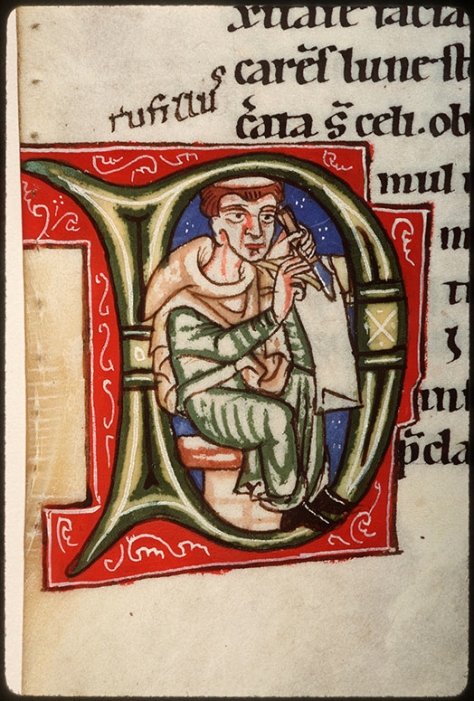
His other selfie is encountered in Cod. Bodmer 127, a collection of saints’ lives kept in the Fondation Martin Bodmer in the Swiss city of Cologny (The Passionary of Weissenau, Figure 2). Here, Rufillus created a more roomy environment, painting himself inside a very large letter R at the outset of the passion of St Martin of Tours (d. 397). Selfies are not frequently encountered in medieval manuscripts, which makes the Rufillus case quite special, given that it entails not one but two “snapshots” of the same person. This post explores what we can learn from the two self-portraits of a monk who is a bit of a showoff – and who is not shy about using the selfie-stick.
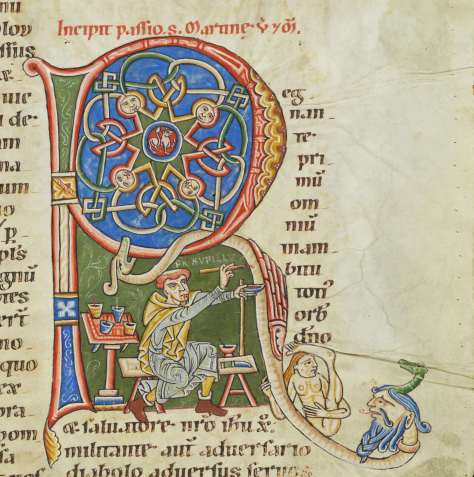
Rufillus the Illuminator
Helpfully, Rufillus identifies himself by providing his name: in the Cologny manuscript he painted it in white above his brush (accompanied by “Fr.” for frater, monk), while in the crowded Amiens initial the name is written right above the decorative letter with pen and ink. Based on the origins of the two manuscripts, scholars place Rufillus in the late-twelfth century Premonstratensian abbey of Weissenau near Ravensburg in the South of Germany (get up to speed on Rufillus in this article by Solange Michon; a useful enumeration of manuscripts from Weissenau is found here). In secondary literature he is commonly regarded (and explicitly labeled as) an illuminator (see for example here and here). Judging from the decoration in the two manuscripts, which include numerous decorated initials and even some full-page miniatures, he was quite accomplished. In his article Michon shows, by highlighting iconographical – design – parallels, that it is the same person who produced the decoration in both manuscripts.
The Cologny manuscript shows the artisan “in the moment,” hard at work decorating the manuscript (Figure 2). The scene is unusually rich in detail and shows us, among other things, what tools were used by medieval illuminators. In one hand Rufillus is holding a bowl filled with red paint; in the other a brush. Cow horns filled with all kind of paints are placed behind him, while a mortar and pestle are placed nearby for preparing additional pigments. In what is a familiar pose for painters today, his right hand is leaning on his left for stability. That hand is in turn supported by a stick placed on the ground – a selfie-stick! With a healthy dose of irony, Rufillus allows us to observe him as he is painting the initial he is inhabiting. In a rather unusual twist, we witness both the artist at work and the result of his toils. By showing himself applying red paint on the letter R he invites the beholder in his atelier, which is a powerful gesture.
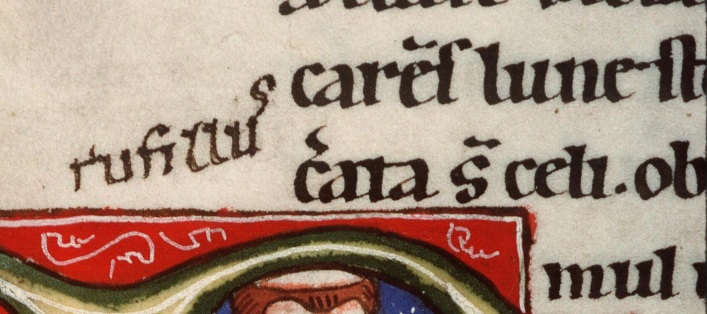
Rufillus the Scribe
While the common designation given to Rufillus by scholars is illuminator or decorator, the second selfie suggests that he was also a scribe. After all, in as much detail as he presents himself as an illuminator in the Cologny manuscript, he shows himself as a scribe in the Amiens codex (Figure 1). In this depiction, too, the paraphernalia of the trade are clearly identifiable, this time the scribe’s: a sheet of parchment, a reed, and a knife to hold down the parchment as well as to cut the nib of the pen. While Rufillus placed himself on a bench in the Cologny painting, the Amiens scene shows him seated in a scribal chair, one that supports his behind as well as the parchment sheet he is writing on. It seems appropriate, in this light, that Rufillus signed his name with pen rather than brush: he stayed in his role. The key observation to make here, however, is that our monk appears to have been active both as illuminator and scribe in the scriptorium of Weissenau (more about such a combination here).
The name “rufillus” written above the Amiens painting provides additional information. Let’s look at it again, this time from up close (Figure 3). The ink used for his name has a brown colour, deviating from the deep-dark black ink of the main text. In other words, main text and name were copied at different moments. The same is suggested by the observation that the pen used for writing the name was much thinner. Moreover, the nib used for the name reveals an imperfection not seen in the main text: the flawed nib produced a thin white line in the central stroke of the letter l. This is obviously a later cut or even a different pen. These observations make sense. In the production of a manuscript the copying of the text came first, followed by the execution of the decoration.
Evidently, Rufillus signed his name when he completed the painting, not while he was copying. This is telling, I think. Rufillus could have identified himself better and more explicitly through a scribal colophon, which is where copyists provide details about themselves (see this post). By contrast, he is far less traditional and added his presence not with pen but with brush. By doing so he inserted the motif of the scribe into the visual narrative of the book, even though its topic did not call for it. This somewhat inappropriate behaviour is amplified by the fact that he then identified this scribe as himself. Through his action, Rufillus squeezed himself into Ambrose’s text and climbed onto the podium of the Church Father. He purposefully attracted attention to his person.
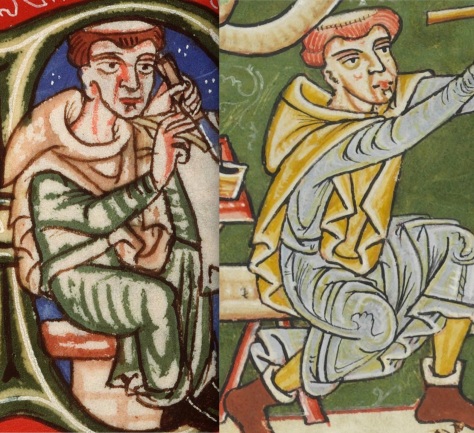
Rufillus the Person
Each of the two manuscripts shows that Rufillus is not lacking in confidence and that he does not mind breaking with the monastic virtue of modesty. It is in the combination of the two selfies, however, that we learn things we otherwise would not have known about him. For example, with Amiens alone we could not be sure that Rufillus produced the decoration in the manuscript as well. After all, the decorator could have produced a portrait of his colleague the scribe, in praise of his activities, or even a generic picture of a scribe at work. Had Cologny been by itself, there would not have been a reason to infer that Rufillus was also involved in scribal activities. Where the two selfies really become quite telling, however, is in the realism they entail. There are striking commonalities that suggest the decorator aimed to provide a realistic depiction of himself, which fits the bill given his pronounced self-promotion.
Striking similarities in his appearance are for example the pronounced eye lids, the shape and colour of his hair (bright red and with recesses), and the sharp lines across the cheeks, starting next to the nose and giving his face a thin appearance (Figure 4). With only one selfie the red hair would have been striking, but the repeated occurrence suggests that Rufillus really was a red-headed monk. This is, of course, why our scribe-illuminator calls himself Rufillus, which is derived from the Latin rūfus, meaning “red-haired” (see also here). In other words, our scribe-illuminator is using a pseudonym, one derived from a pronounced feature in his appearance – his hair. For a person who should strive to be modest and for whom the monastic community ought to be more important than the individual in it, relating one’s identity to a bodily feature seems peculiar. Yet, in light of what we have learned about Rufillus, it is no surprise.

Rufillus the Old Man?
A third manuscript exists that was copied and illuminated by our anonymous red-headed monk, although it is not usually mentioned in discussions about Rufillus and his self-portraits. The codex in question is Bloomington, Indiana University, Ricketts 20 (Peter Lombard, Commentary on the Psalms), which is assumed to have been produced in c. 1200-15, a few decades after Amiens and Cologny, and which was part of the library of Weissenau Abbey (Figure 5). In the description of the manuscript in his Gilding the Lilly (p. 60), Christopher de Hamel identified the scribe and illuminator as Rufillus (his assessment is quoted in this manuscript description). One can see from the handwriting that Rufillus was older when he made the Bloomington manuscript: his firm hand, with which he once produced such sharp and disciplined script, appears shaky and weak.
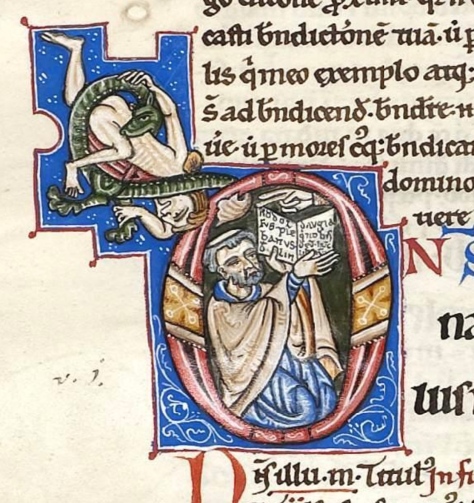
Another initial letter in the same manuscript provides a bit of history about its origins (Figure 6). A person is shown holding an open book in which the following is written: “Rodolfus plebanus de Lindaugia. q[ui] nobis dedit hu[n]c libru[m],” “Rudolf, parish priest of Lindau, who gave us this book” (source, with minor correction in the transcription). The painting shows the person who “gave” the manuscript to Weissenau abbey. Because the maker of the book, our Rufillus, is commonly regarded as a monk of Weissenau, this inscription would suggest that Rudolf paid for the materials, which is a bit of stretch but possible. Had our anonymous monk not been so firmly tied to Weissenau abbey in secondary literature, this inscription could indicate that Rufillus and Rudolf were one and the same person: he first made the manuscript, then donated it to the abbey. If this speculative inference were true, it would place our red-headed scribe-illuminator outside the abbey of Weissenau – and turn the letter O in Figure 6 into a third selfie, showing Rufillus as an old man.
Rufillus and the Weissenau scriptorium:
- Jonathan James Graham Alexander, Medieval Illuminators and Their Methods of Work (New Haven & London: Yale University Press, 1992), pp. 16-17.
- Walter Berschin, “Rufillus von Weissenau (um 1200) in seiner Buchmalerwerkstatt,” in: Walter Berschin (ed.), Mittelateinische Studien II (Heidelberg: Mattes Verlag, 2010), pp. 353-56.
- Christopher de Hamel, Gilding the Lilly: A Hundred Medieval and Illuminated Manuscripts in the Lilly Library (Bloomington: The Lilly Library, 2010), p. 60.
- Solange Michon, “Un moine enluminateur de XIIe siècle: Frère Rufillus de Weissenau,” Zeitschrift für schweizerische Archäologie und Kunstgeschichte 44 (1987), 1-7.
- Solange Michon, Le Grand Passionnaire enluminé de Weissenau et son scriptorium autour de 1200 (Genève: Slatkine, 1990).
- Elke Wenzel, Die mittelalterliche Bibliothek der Abtei Weißenau (Frankfurt am Main: Peter Lang, 1998).
Selfies and self-portraits:
- James Hall, The Selfportrait: A Cultural History (New York: Thames & Hudson, 2014).
- Adi Kuntsman, Selfie Citizenship (Cham: Palgrave, 2017).
- “Medieval Selfies,” medievalbooks.nl (19 September, 2014).
- “Medieval Selfies,” British Library Medieval Manuscripts Blog (5 August, 2016).

I plan to. First stop, attaining more information about the individuals in the abbey around 1200. It’s a great topic of research, these 2 (3?) selfies.
LikeLike
Absolutely fascinating to look into the face of the artist. Even from such slender threads, it appears he had quite the personality. I hope that you yourself, or other historians, do take up the further research potential you discussed at the end.
LikeLike
Good point. Given that we don’t know his real name (unless my inference at end is correct) we can’t tell!
LikeLike
And a handsome lad too! Were his origins perhaps Irish?
LikeLike
These are the ones from Shreveport Louisiana using Father Joseph Cina World War 2 veteran deceased December 1985 my older brother Emil Anthony Cina Vietnam Vet died December 1998and my younger brother Christopher James Cina killed/died 1962. Ask Barbra Cina maiden name Paglousio Grandmother Lilian Paglusio maiden name Triano what happened when? My Mother Barbra her Son Joseph Cina Jr. went to the store Brookport Street Covina next to Charter Oaks Elementary School where I attended Kinder thru 2nd Grade before moving to 1716 Sixth Street Alhambra CA. Katrina use to clean my home at: 5842 Yarmouth Ave Encino, CA 91316 and at 24425 Woolsey Canyon Rd Spc 21, West Hills, CA 91304. This is where Kia Leon and Katrina Leon stole my and Cindy RIP financial and personal information to use for illegal businesses and illegal drug sales. The ones listed below worked for: MOLLY MAID of the West Valley Woodland Hills, CA • (818) 716-5568 MOLLY MAID of Burbank Burbank, CA • (818) 972-2745 MOLLY MAID of San Gabriel Valley Monrovia, CA • (626) 759-9500 Katrina Leon Phone Number | Katrina Leon Address – Page 2 … https://www.peoplesmart.com/find/name/katrina-leon/2 Page 2 of results for Katrina Leon address, phone number, send email, public records & background … Los Angeles, CA; Inglewood, CA; Long Beach, CA. 5804 W 78th Pl Los Angeles Ca 90045 Address Search Results https://www.fastpeoplesearch.com/address/5804-w-78th-pl_los-angeles-ca-90045 Used to live: Los Angeles, CA, Glendale, CA, Surfside Beach, SC, Hernando, FL, Playa … CA, Irvine, CA, Huntington Beach, CA, Huntingtn Bch, CA, Long Beach, CA … Maria De Leon , Katrina M De Leon , Ms Katrina M Deleon , Katrina Leon. Katrina Deleon Mcdonald – phone, email, social & more Socialcatfish … https://socialcatfish.com/search/katrina-deleon-mcdonald-595752/ 25 Records – 25 results – We found Katrina Deleon Mcdonald in 28 states including Alma, MI, Auburn, WA. … Covina, CA, West Covina, CA, Costa Mesa, CA, Long Beach, CA, Huntington Beach, CA, Garden Grove, CA … De Leon Katrina. Katie Leon Found – Phone, Address, Email & More | BeenVerified https://www.beenverified.com › People Search › Lemmon to Lewallen › Leon to Leon 16 results – We found Katie Leon in 6 states. … 747 Date Ave, Chula Vista, CA; 5855 E State University Dr, Long Beach, CA; 419 E Tujunga Ave, Burbank, CA.
On Thu, Sep 20, 2018 at 10:52 AM, medievalbooks wrote:
> Erik Kwakkel posted: “Selfies are by no means an exclusively modern > phenomenon. As shown in a previous post on medieval selfies, some > decorators made self-portraits in manuscripts, showing that the practice > predates print – albeit without the use of a camera. They did so to id” >
LikeLike
Thank you so much Joyce, this is really nice to hear! As you may have guessed, I enjoy writing about manuscripts in the casual language of a blog. BTW, you may like to hear that the first fifty posts of this blog will appear in book form (see the PS at the end of the “About this Blog” section).
LikeLike
You are an excellent writer and an exceptional scholar and historian. I have read your work before. I read your article about doodles and recall a figure from a manuscript in Carpentras. This post so impressed me that I had to thank you for all the research that went into this story. I am sure you will continue to write more delightful stories, and I look forward to reading them.
LikeLike
Thanks! I thought his story was straightforward and his background mostly mapped, but writing the last part of the post I realized there is still research potential out there.
LikeLiked by 1 person
This is fascinating! Thank you for (and congratulations) on your scrupulous research — for through it you’ve given Rufillus new life.
LikeLike